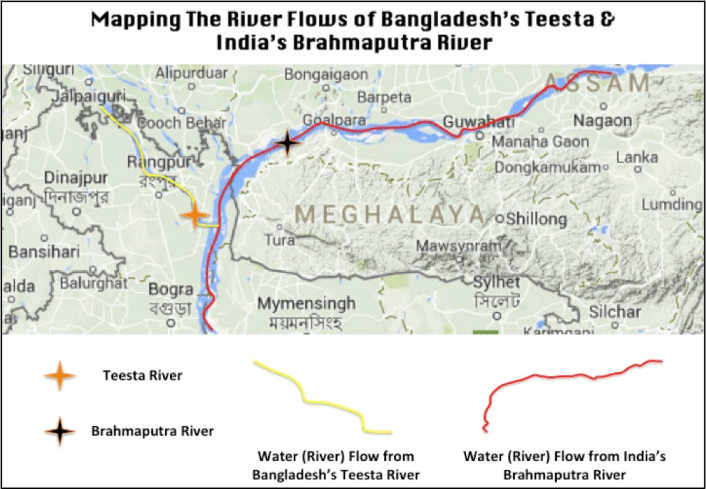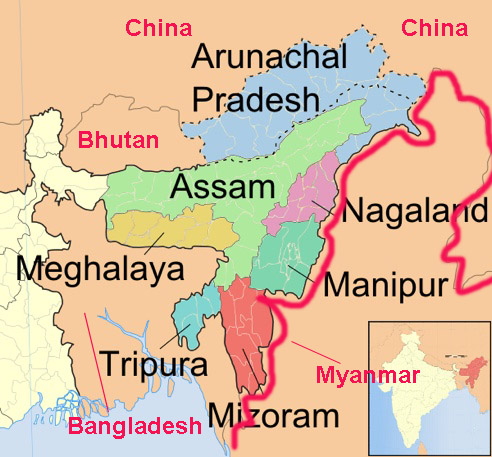These MCQs are based on Today’s Targets given here
1. Teesta River flows through Indian states of West Bengal, Sikkim and Meghalaya.
2. Teesta River is a tributary of River Brahmaputra.
Choose the correct statements from the option given below:
a) 1 only
b) 2 only
c) Both 1 and 2
d) Neither 1 nor 2
Ans. B
Explanation:
- The Teesta River (or Tista River) is a 309 km (192 mi) long river flowing through the Indian states of West Bengal and Sikkim through Bangladesh before emptying to the Bay of Bengal.
- It carves out from the verdant Himalayas in temperate and tropical river valleys and forms the border between Sikkim and West Bengal.
- It flows through the cities of Rangpo, Jalpaiguri and Kalimpong and joins the Jamuna (Brahmaputra) in Bangladesh.
- It drains an area of 12,540 km2

Q.2) Which of the following states share boundary with Bangladesh:
1. West Bengal
2. Sikkim
3. Assam
4. Meghalaya
5. Tripura
6. Manipur
7. Mizoram
Choose the correct statements from the option given below:
a) 1, 2, 3 and 5
b) 1, 2, 4, and 7
c) 1, 3, 4, 5 and 7
d) 1, 3, 4, 5 and 6
Ans. C
Explanation:

Q.3) Consider the following statements about Whistleblowers Protection Act, 2014:
1. The WBP law has provisions for concealing the identity of a whistle-blower.
2. The law empowers the competent authorities to accord them protection, which includes police protection and penalising those who victimise them.
Choose the correct statements from the option given below:
a) 1 only
b) 2 only
c) Both 1 and 2
d) Neither 1 nor 2
Ans. C
Explanation:
http://www.ias4sure.com/wikiias/gs2/whistleblower-issue-in-india/
Q.4) Which of the following is correctly matched:
1. Santhal : Orissa
2. Nishi : North East
3. Bhil : Gujrat
Select the correct answer using the code given below:
a) 1 and 2 only
b) 1 and 3 only
c) 2 and 3 only
d) 1, 2 and 3
Ans. C
Source: NCERT 8th: Our Past – III, Chapter 4, Figure 4, 5 & 6
Q.5) Company introduced the Permanent Settlement in 1793 for which of the following reasons:
1. To ensure a regular flow of revenue
2. To encourage the zamindars to invest in improving the land
3. For recognising rajas and taluqdars as zamindars
4. For the improvement of agriculture
Select the correct answer using the code given below:
a) 1, 2 and 3 only
b) 1, 2 and 4 only
c) 1, 3 and 4 only
d) 2, 3 and 4 only
Ans. B
Explanation:
Most Company officials began to feel that investment in land had to be encouraged and agriculture had to be improved. How was this to be done? After two decades of debate on the question, the Company finally introduced the Permanent Settlement in 1793. By the terms of the settlement, the rajas and taluqdars were recognised as zamindars. They were asked to collect rent from the peasants and pay revenue to the Company. The amount to be paid was fixed permanently, that is, it
was not to be increased ever in future. It was felt that this would ensure a regular flow of revenue into the Company’s coffers and at the same time encourage the zamindars to invest in improving the land. Since the revenue demand of the state would not be increased, the zamindar would benefit from increased production from the land.
Source: NCERT 8th: Our Past – III, Chapter 3, Page 28
Q-4
Santhal tribe is also found in Odisha. So answer should be “D”
Q-5
Acc to your explanation all 4 statements are correct
kindly clarify